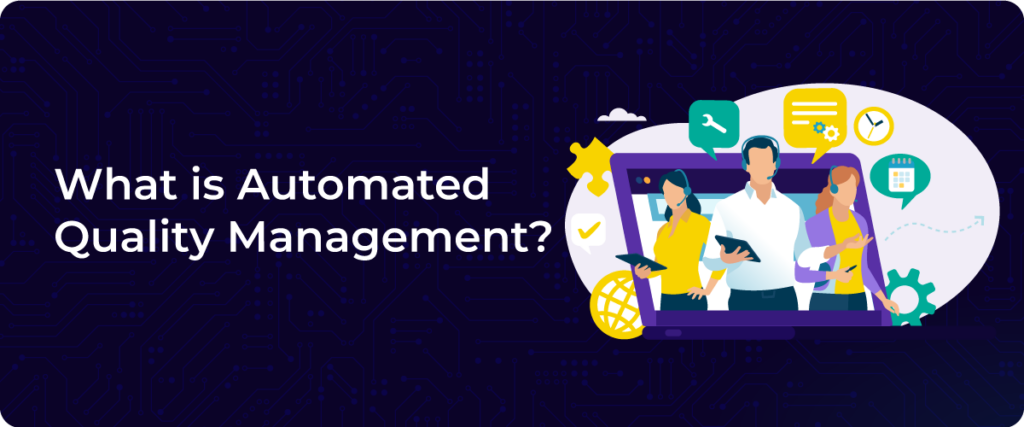
According to Forrester’s research report 75% of businesses have implemented AI-based call monitoring that has improved customer satisfaction and overall customer experience. For example, If an Insurance company is suddenly incompatible with customer interactions and delays with long settlements for which one solution to dissolve the issue is implementing an AI-based call monitoring system that analyzes calls in real-time and provides insights into customer sentiment that leads to profit in business and customer satisfaction.
What were the traditional methods used for Call Quality Monitoring?
The traditional method of monitoring call quality involves three main components:
1. Call recording
- This method allows supervisors to have assess of agent performance based on their actual interactions with the customers using standard forms or checklists to evaluate the calls, they can look at important factors like following scripts, voice tone, information accuracy, and customer service skills. As this is a traditional way, it is time-consuming.
2. Customer Feedback Surveys
- After a call to gauge the effectiveness of the assisting agents, surveys are provided to the customers.
- Customer Feedback surveys may include Customer Satisfaction (CSAT) scoring, it is conducted over the phone or via email after the call gets disconnected and another metric is Net Promoter Score (NPS) that helps to measure overall satisfaction of the customer with the service provided over time.
3. Measurement of key metrics
- Key metrics such as First Contact Resolution (FCR), helps to measure the percentage of customer issues that get resolved on the first interaction without needing any follow-up.
- Average Handling Time (AHT) is the total average duration of customer interaction, including the time spent talking with the agent and any follow-up work.
Average Handling Time (AHT)
The most effective call centers employ specialized staff to monitor call quality. These personnel work closely with agents to assess and adjust key metrics and identify areas for improvement in individual performance. However, there are limitations to monitor call quality when a call center handles 50,000 or more calls in a day, it becomes almost impossible to listen to each one of them and tag them.
As a result, metrics such as FCR and AHT are not fully representative of the unique challenges posed by specific calls and the influence of external initiatives.
How can AI-based call monitoring significantly enhance the customer experience?
It is important to use AI-based call monitoring because it can enhance customer experience. Let’s explore a few benefits:
1) Real-Time Monitoring & Analysis

- Real-time monitoring of voice and text interactions is becoming a critical trend in customer service.
- By analyzing conversations as they happen, AI-powered platforms can provide immediate feedback and assistance to customer service agents.
- Improving response times and service quality.
2) Performance Metrics & Reporting
- Key Metrics like Call Handling Time, Average Wait Time, and Customer Satisfaction scores can be analyzed by AI to assess agent performance.
- This information can identify specific areas where agents can enhance their skills, allowing for focused training and coaching to improve service quality.
3) AI insights & key moment identification

- AI tools can analyze historical data to predict future trends, customer behaviors, and call volumes.
- AI can analyze valuable insights into customer interactions and understand customer emotions and satisfaction levels, providing valuable insights that can inform improvements in service and products.
- This allows for better forecasting and strategic planning.
4) Enhanced Quality Assurance
- AI ensures compliance with service protocols and quality standards by evaluating each call against specific criteria automatically, reducing variation in service quality.
- It uses speech analytics to monitor calls in real-time, ensuring compliance with regulations.
- AI identifies customer sentiments, helping agents tailor responses effectively.
- Automated QA processes enhance agent training and performance by providing actionable insights from call data.
Beyond Efficiency: The Extended Outcomes
1. Improved customer satisfaction
Faster, more accurate resolutions lead to happier customers.
2. Enhanced employee experience
With AI handling routine tasks, agents can focus on more complex, rewarding interactions.
3. Data-driven insights
The wealth of data collected can inform strategic decisions across the organization.
4. Compliance assurance
AI can flag potential compliance issues in real time, reducing risk.
Conclusion
In today’s technology-evolving, competitive landscape, customer service centers can’t afford to lag. The use of AI in call centers signifies a significant change in customer service practices that are more effective, customized, and informative, and the potential for AI to revolutionize the call center industry is just as significant. Thus, AI-based call monitoring is essential for those who want to deliver exceptional customer experiences while optimizing their operations.
#1 Product of the Day on Product Hunt is ConvoZen.AI. Are you ready to transform your customer service center with the power of AI?
Click here to request a live demo and see how the implementation of AI-based call monitoring can transform your business operations.
FAQs
AI-based call monitoring utilizes artificial intelligence and machine learning algorithms to analyze and assess customer interactions during phone calls.
The technology transcribes conversations in real time, evaluates the sentiment, and identifies key topics and phrases.
This allows businesses to gain insights into customer satisfaction, agent performance, and areas for improvement.
AI can automatically flag issues such as long wait times, poor service quality, or compliance breaches, providing actionable data to enhance the overall customer experience.
AI-based call monitoring improves customer satisfaction by providing businesses with detailed insights into customer interactions.
By analyzing call data, companies can identify common pain points and areas where agents may need additional training.
This helps in refining call scripts, optimizing response times, and personalizing customer interactions.
Furthermore, real-time alerts about negative sentiment or issues allow companies to address problems promptly, leading to quicker resolutions and a more positive customer experience.
The key benefits of AI-based call monitoring for businesses include:
Enhanced Quality Control: Automated analysis ensures consistent evaluation of calls, identifying deviations from best practices and helping maintain high service standards.
Actionable Insights: AI provides data-driven insights into customer behavior, preferences, and pain points, enabling businesses to make informed decisions.
Real-Time Feedback: Immediate alerts about potential issues allow for quick corrective actions, improving service delivery and customer satisfaction.
Agent Performance Improvement: By assessing agent interactions, AI helps in identifying training needs and enhancing overall performance.
Some potential challenges of implementing AI-based call monitoring include:
Privacy Concerns: Ensuring compliance with data protection regulations and maintaining customer privacy is crucial. Clear communication with customers about data usage and obtaining consent is essential.
Initial Costs: Implementing AI-based call monitoring systems can involve significant upfront costs, including software acquisition and integration.
Accuracy of AI: While AI technology is advancing, it may still have limitations in accurately understanding nuanced conversations or detecting sarcasm.
To get started with AI-based call monitoring, businesses should follow these steps:
Assess Needs: Determine the specific goals and challenges you want to address with call monitoring, such as improving customer satisfaction or enhancing agent performance.
Research Solutions: Explore various AI-based call monitoring solutions to find one that fits your needs and budget, and integrates well with your existing systems.
Training: Provide training for your team on how to use the new system and interpret the data it generates.
Continuous Improvement: Use the insights gained to continuously refine your customer service strategies and monitor the impact on customer experience. Regularly review and adjust the system to ensure it meets evolving needs.


